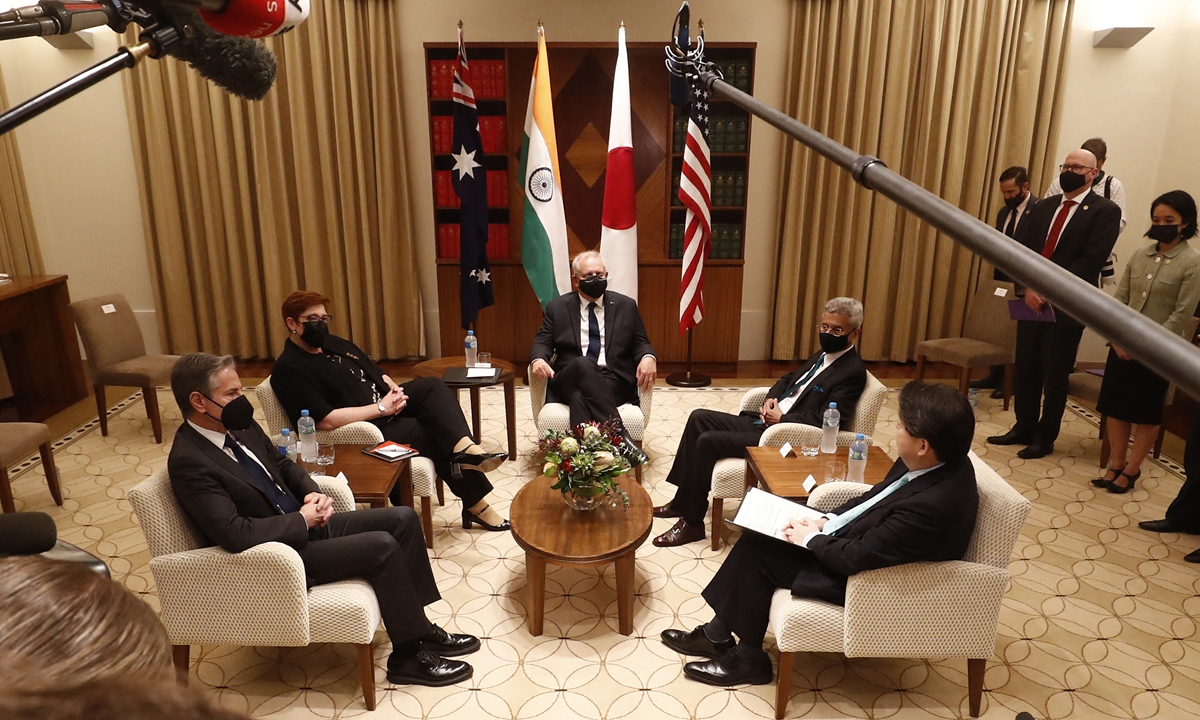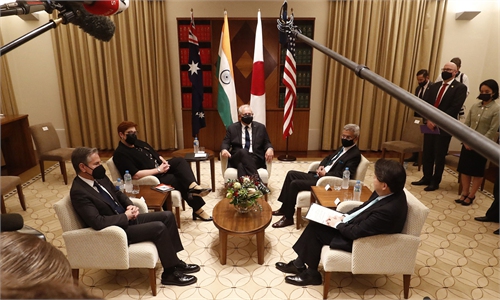
Australian Prime Minister Scott Morrison (center) addresses US Secretary of State Antony Blinken (left), Australian Foreign Minister Marise Payne (2nd from left), Indian External Affairs Minister Subrahmanyam Jaishankar (2nd from right) and Japan's Foreign Minister Yoshimasa Hayashi (right) before a Quad meeting in Melbourne on February 11, 2022. Photo: AFP
The foreign ministers of Australia, India, Japan and the US met in Melbourne, Australia Friday, for the fourth Quad Foreign Ministers' Meeting. In a joint statement released after the meeting, support for the Outlook on the Indo-Pacific by the Association of Southeast Asian Nations (ASEAN) was highlighted. This led to media discussions about Quad expansion, especially how the Quad could work with other multilateral organizations such as ASEAN to counterbalance China's influence.The Quad has two tasks in terms of strengthening mechanism. One is upgrading the mechanism and the other is expansion. Given that the Quad now has annual ministerial meetings and summits, its most important task is expansion, both in fields of cooperation and of membership. The expansion of membership is more crucial, as the Quad has already changed from a security mechanism into a comprehensive framework involving cooperation on anti-pandemic efforts, high-tech, climate change, security and the economy.
Scholars at home and abroad home believe that Quad+ includes at least two formats, one of which is directly absorbing certain countries as fixed members. But it seems to be difficult, since everyone now basically agrees that the Quad aims at building a regional security network with allied partners in order to contain China. Most countries and regions do not want to choose sides between China and the US and are therefore apprehensive about joining the Quad directly.
This is why a second format of ad hoc, issue-based and flexible organization has emerged. During the most difficult time fighting the COVID-19 pandemic in 2020, the US hosted several meetings of Quad countries, which also included Brazil, Israel, and South Korea, to discuss a global response to the pandemic, in an issue-based Quad+ format. Such a format may continue into the future, or even be fixed to some extent. The Quad cooperation with ASEAN, which the US highlighted this time, could be similar.
The specific mention of Quad support for ASEAN centrality in the joint statement suggests that the US-led mechanisms including Quad, AUKUS, and G7 could be connected in the future with the existing dialogue mechanisms of ASEAN. The most likely format will be to hold Quad+ meetings. After all, many ministerial meetings of the Quad in the past were actually held on the sidelines of the ASEAN series of meetings.
But it is unlikely that ASEAN as a whole will get involved in Quad+ meetings. ASEAN unity is facing challenges and only a few ASEAN countries are closer to the US, so it is more likely that just these ASEAN countries will be connected to the Quad. Even then, it will be more symbolic than practical.
Moreover, the US has been criticized for its weak economic ties in the Asia-Pacific region and the proposed Indo-Pacific economic framework has not yet been introduced. Without stronger economic connections, the effect of US Indo-Pacific Strategy will be greatly reduced. After all, most ASEAN countries are concerned about economic development, especially after suffering during the epidemic. Even if the US really strengthens its investment in ASEAN, it will not be able to completely replace or squeeze China out of the region. The US has its own advantages in the high-tech field, and China is competent in infrastructure. Both countries are providing different public goods to this region.
The US keeps elevating the status of the Quad, leading ASEAN countries to worry about the impact on its centrality and unity. After all, the more there are dialogues under US-led structures including the Quad, the more they will dominate the regional order and split ASEAN's unity.
Thus, while the US will certainly persist in its efforts to expand its engagement with ASEAN, the bloc is bound to be very cautious about it. ASEAN has been focusing on maintaining the balance of powers and attracting investment to the region. As a result, both the Indo-Pacific Strategy of the US and China's presence in the region are welcomed. At a time when China has sufficient economic dynamism and market opportunities, ASEAN is unlikely to be fully attracted to the US Indo-Pacific Strategy or to Quad expansion.
The author is a researcher from the National Institute of International Strategy under the Chinese Academy of Social Sciences. opinion@globaltimes.com.cn


